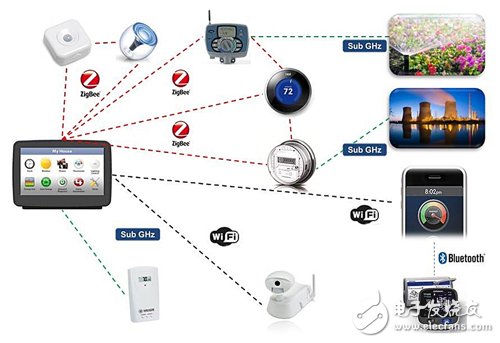One of the important driving forces of the Internet of Things (IoT) is the emergence of low-power wireless sensors. From smart meters (Smart Meter) to transportation systems, from security systems to building automation, sensors are more and more widely used in various applications. For wireless sensors, characteristics such as scalability, range, sleep current, and reliability are critical. Although the data transmission rate required by some end nodes is relatively low, real-time reports are aggregated in large-scale networks. , Has meant the coming of the era of Big Data.
According to the prediction of the Global System for Mobile Communications (GSM) Alliance, there will be approximately 50 billion devices equipped with wireless communications by 2020, of which mobile devices and personal computers (PC) account for only 25%, and the rest are mostly Internet of Things devices, which is obvious Its business opportunities are huge.
With the development of the Internet of Things, the deployment of Smart Grid is also accelerating. Since the new generation power network emphasizes the instant communication between devices, there are many wireless connection technologies that have attracted attention. The most common ones include wireless. Local area network (Wi-Fi), Bluetooth (Bluetooth), ZigBee and Sub-GHz technology-based solutions, each solution has advantages and disadvantages, in this interconnected world, the above wireless technologies will coexist (Figure 1 ).

Figure 1 For different IoT applications, multiple wireless communication technologies will coexist at the same time.
Wireless communication technology plays an important role in realizing smart energy management
In order to provide better services for end users, public utilities and municipalities have begun to expand smart metering systems to solve the problem of increasing real-time data. Public utilities can use smart meters to view customers' energy consumption information more frequently and effectively At the same time, it can also quickly identify, isolate and solve power failure problems, and consumers can also obtain relevant information through interconnection.
Network devices in smart energy and smart home systems can report their usage status and power consumption in real time, and can respond to control commands issued by public utilities, such as dishwashers can be started when the electricity cost is the lowest, or remind users when to buy Dishwashing liquid makes the use of electronic devices more energy-efficient and efficient. Similarly, in the railway transportation network, wireless sensors can be used to remotely monitor the vast rail network, and technicians can identify maintenance needs in advance, reducing the cost and delay of manually patrolling the rails.
For a network environment where many wireless sensors are introduced, some sensors perform status updates every second, transmitting only a few bytes of information at a time, but a single building may have tens of thousands of nodes, and The coverage of the smart grid is larger to several towns, so reliability, scalability and power efficiency are very important.
For example, the Aria Hotel in Las Vegas, USA, deploys more than 70,000 communication nodes that use ZigBee mesh networks to control lighting, air conditioning, and many other services around the building. In most applications, the sensor installation location is mostly unable to connect to the main power supply and can only be powered by a battery. Therefore, a reliable network architecture requires the ability to process a large amount of collected data, but the sensor node itself must also use very low power consumption. Only operation can truly achieve smart energy management.
The combination of reliability, scalability, and power efficiency clearly define the communication technology requirements that wireless sensor nodes can use. System integrators must not only consider the advantages and disadvantages of the selected topology and wireless protocol, but also consider the existing physical properties of wireless technology, such as concrete walls and multipath fading are disadvantageous for any wireless system, but there are also ways Reduce the impact. To solve this problem, all countries have relevant regulations governing radio frequency bands and available frequency ranges.
Among them, 2.4GHz is a global frequency band that does not require authorization, so its wireless system design can serve the world's major markets. The most common Wi-Fi is based on the communication technology of the 2.4GHz frequency band, which can quickly transfer large amounts of data between two nodes. However, its power consumption is relatively high. In a star architecture, each network access point (AP) is limited to no more than fifteen to thirty-two clients. Bluetooth also uses the 2.4GHz band as a point-to-point transmission solution for portable devices, but only supports a few nodes; the ZigBee band is also the same, but only used to meet the special needs of low-power wireless sensor nodes. Table 1 summarizes the main features and functions of current wireless network technologies.

MC Air series Showcase LED Display is mainly used in clothes chain store, Shopping mall, Library, Supermarket and so on. Product categories of LED Display For Fixed, Indoor Showcase led display and Outdoor Showcase led display. We have R & D and manufacturing team and the perfect after-sales service and technical support for wholesale high quality showcase Led Display,.
Showcase led display is highly customized regards to pixel pitches, resolution, sizes, shapes etc. Our showcase led display walls enjoys long life span, they are weatherproof units and can tolerate dust, humidity or rain.
For Outdoor Showcase led display, it is viewable in direct sunlight. The picture quality is not compromised in our solution, hence the display is crystal clear despite it`s day time.
Showcase LED Display
Showcase LED Display,Transparent LED Screen,LED Display Signs,Showcase LED Advertising Display
Shenzhen Macion Optoelectronics Technology Co.,Ltd. , https://www.macion-led.com
